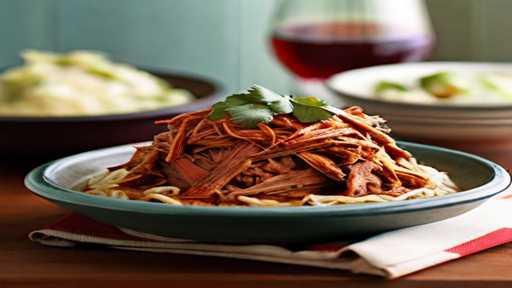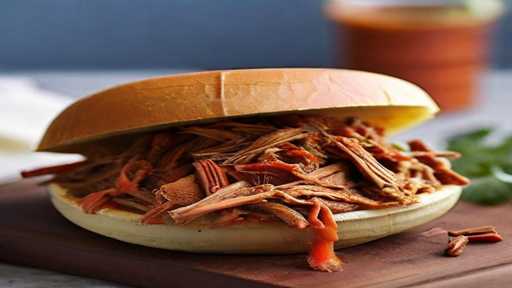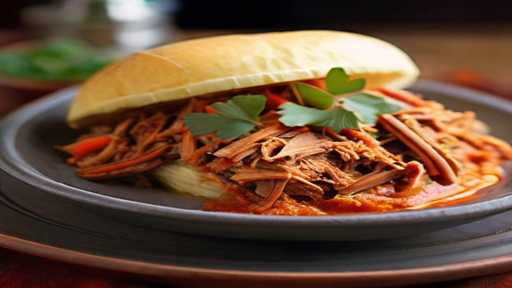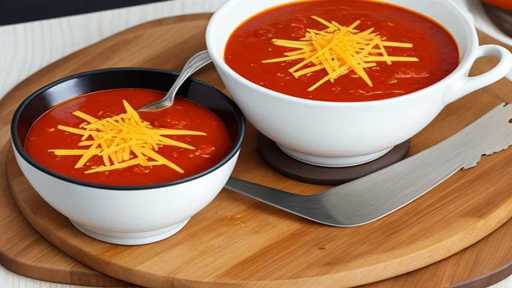Authentic Spanish pulled pork with smoked paprika
Spanish Pulled Pork with Smoked Paprika This dish of Spanish origin offers a rich fusion of flavours. Succulent pork is slow-cooked to perfection and infused with the aromatic essence of smoked paprika to create a flavorful masterpiece that will tantalize your taste buds.
Spanish Pulled Pork with Smoked Paprika
Cuisine
Spanish
Total Prep Time
4 Hours 20 minutes
Resting Time: 15 minutes
Difficulty
Medium
Spanish Pulled Pork with Smoked Paprika Ingredients:
- 1. 2-3 pounds boneless pork shoulder
- 2. 2 tablespoons smoked paprika
- 3. 1 tablespoon sweet paprika
- 4. 1 teaspoon cumin powder
- 5. 1 teaspoon dried oregano
- 6. Garlic powder 1 teaspoon
- 7. Onion powder 1 teaspoon
- 8. Salt 1 teaspoon
- 9. Black pepper 1/2 teaspoon
- 10. Cayenne pepper 1/4 teaspoon (adjust to taste)
- 11. 1 cup chicken or vegetable stock
- 12. 1/2 cup dry white wine (optional)
- 13. 1 onion, thinly sliced
- 14. 4 garlic cloves, minced
- 15. 2 bay leaves
- 16. 2 tablespoons olive oil
- 17. Juice of 1 orange
- 18. Juice of 1 lime
- 19. 1 tablespoon apple cider vinegar
- Optional Substitutes:
- • If smoked paprika is not available, use regular paprika Yes, but it may leave behind a smoky flavor. It will be less noticeable.
- • You can also use pork loin or a well-marbled pork fillet instead of pork shoulder.
- • If you prefer a non-alcoholic option, you can substitute chicken or vegetable broth for the dry white wine.
- • If you don’t have apple cider vinegar, you can use red wine vinegar instead.
Cooking Instructions: Spanish Pulled Pork with Smoked Paprika
- Preparation:
- 1. Preheat oven: Preheat oven to 325°F (163°C).
- 2. Season the pork: In a small bowl, combine the smoked paprika, ground cumin, dried oregano, salt, and black pepper. Rub the spice mixture evenly onto the pork shoulder, making sure it is well coated.
- 3. Sauté Flavor: Heat a large oven-safe Dutch oven or deep skillet over medium-high heat. Add a little olive oil. Fry the minced garlic and sliced onion until soft and fragrant.
- 4. Sauteed Pork: Set aside the sautéed seasonings and add a little oil if needed. Grill the seasoned pork shoulder on all sides until golden brown. This extra effort adds depth to the dish.
- 5. Deglaze the pan: Pour in some white wine to deglaze the pan and scrape any flavorings from the bottom. Give the wine a few minutes to gently simmer.
- Cook:
- 6. Add liquid ingredients: Add chicken stock, add bay leaf. Make sure the liquid covers about half of the sides of the pork.
- 7. Cover and bake: Cover the casserole dish with a tight-fitting lid and place in the preheated oven. Simmer the pork for about 3 to 3.5 hours, or until fork-tender and easily falls apart.
- 8. Check and season: Check the pork occasionally and season with the pan juices. Add more chicken broth as needed to prevent dryness.
- 9. Shred the pork: Once the pork is tender, remove it from the oven. Using two forks, place the meat directly into the casserole and mix with the aromatic juices.
- 10. Serving Instructions: Serve Spanish pulled pork on a platter, as a filling for tacos, sandwiches, or with your favorite side dish.
- Key points:
- • Make sure the pork is well coated with the seasoning mixture for maximum flavor.
- • Brown the pork before slow cooking to create a rich caramelized skin.
- • Watch the liquid level during baking to prevent drying.
- • Season to taste before eating.
Kitchen tools and equipment: Spanish Pulled Pork with Smoked Paprika
- 1. Slow cooker or crockpot: Cook slowly until the pork is tender and falls apart easily.
- 2. Gyuto: A knife used to cut pork shoulder into manageable pieces.
- 3. Cutting Board: Provides a stable surface for cutting and preparing food.
- 4. Garlic Press: Crush garlic to season pulled pork.
- 5. Large mixing bowl: Used for mixing spice mixtures and marinating pork.
- 6. Measuring spoons and cups: For accurately measuring spices and other ingredients.
- 7. Tongs: Used for turning and handling pork when grilling or cooking.
- 8. Skillet or Skillet: Used to sear pork and add depth of flavor before slow cooking.
- 9. Wooden spoon or spatula: Used to stir and turn the pork in the pot.
- 10. Can opener: If your recipe calls for canned ingredients such as tomatoes or beans.
- 11. Zester or Microplane: Peel citrus fruits for a fresh taste.
- 12. Pot: If you want to prepare sauces and glazes for pulled pork.
- 13. Serving platter or bowl: For serving the finished dish.
- 14. Fork and knife: Chop and serve pulled pork.
- 15. Aluminum foil: If you need to tent or cover the pork at certain stages of cooking.
- 16. Heat-resistant gloves: Helpful when handling hot slow cooker inserts and separating cooked pork.
- 17. Plastic wrap or plastic wrap: For marinating or covering food in the refrigerator.
Tips for cooking Spanish Pulled Pork with Smoked Paprika:

- 1. Choose the right cut of pork: When making Spanish pulled pork, choose a highly marbled cut such as pork shoulder or pork loin. Due to its high fat content, it becomes juicy and fragrant after slow cooking.
- 2. Marinate overnight: For maximum flavor, marinate pork overnight in a mixture of smoked paprika, garlic, olive oil, and other spices. This allows the rich Spanish flavor to infuse the meat, resulting in a juicier dish.
- 3. Low and slow cooking: Patience is key when preparing pulled pork. By slowly simmering marinated pork at a low temperature (approximately 135 degrees Celsius), the meat becomes soft and easy to cut. This may take him 6-8 hours. So, plan accordingly.
- 4. Use smoked paprika wisely: Smoked paprika is the star of this dish, giving it a unique flavor. For best results, use high-quality smoked paprika. Adjust the amount depending on your smoke flavor preference. However, be careful not to make the dish too strong.
- 5. Brighten up your pulled pork with a pinch of citrus. A squeeze of fresh orange or lemon juice while cooking provides a bright, tangy flavor that counters the smoky flavor.
- 6. Adjust Spice Level: Adjust the spice level to your liking. If you prefer a milder dish, reduce the amount of chili powder or omit it completely. Consider using a small pinch of cayenne pepper for an added heat.
- 7. Serve with garnishes: Pulled pork is delicious on its own, but you can also serve it with traditional Spanish accompaniments like saffron rice, garlic aioli, or a simple green salad. These combinations can complement the flavor and texture of the dish.
- 8. Make ahead: Spanish pulled pork is a great dish to make ahead of time. Cook the pork the day before and leave it in the broth overnight. Reheating slowly before eating allows the flavors to meld better.
- 9. Consider dietary restrictions: For people with dietary restrictions, this recipe is easy to adapt. Use lean pork for lower fat content, and adjust seasoning amounts or substitute certain ingredients to suit your tastes and allergies.
- 10. Experiment with wood chips: If you have a smoker, consider using wood chips (such as hickory or apple wood) during the cooking process. This gives the pulled pork an extra smoky layer and improves the overall flavor profile.
Presentation suggestions for Spanish Pulled Pork with Smoked Paprika:

- 1. Presentation:
- • Arrange the Spanish pulled pork on a large plate so that the rich, flavorful juices pool around the meat.
- • Garnish with chopped parsley for a pop of color and freshness.
- • Serve pulled pork in a rustic bowl or on a bed of Spanish rice for an authentic flavor.
- 2. Side Menu:
- • Serve Spanish pulled pork with fluffy rice infused with saffron for a smoky flavor.
- • Serve warm, crispy baguette slices or soft tortillas on the side so guests can create their own flavorful pulled pork sandwiches or wraps.
- • Balance the richness of your meal with a bowl of tangy homemade tomato salsa or a cooling cucumber yogurt salad.
- 3. Garnish:
- • Sprinkle a pinch of smoked paprika on the pulled pork just before serving to enhance its smoky flavor.
- • Add a little extra virgin olive oil for richness and depth.
- • Place lemon wedges on a platter for guests to squeeze into their own portions to create lemon flavor and lemon contrast.
- 4. Drink Pairings:
- • Pair Spanish pulled pork with a Spanish red wine like Tempranillo to bring out the bold flavors of your dish.
- • Refreshing Sangria is made with lots of citrus and a touch of sparkling water for a festive atmosphere and an indulgent beverage option.
Storage and Leftovers of pulled pork with smoked paprika:

- 1. Refrigeration: Once you have prepared Spanish Smoked Paprika Rudo Pork and have leftovers, it is important to store them properly. Allow remaining portion to cool to room temperature before transferring to an airtight container. Place the container in the refrigerator immediately and make sure it is tightly sealed to preserve freshness.
- 2. Duration: Use leftovers within 3-4 days to ensure optimal taste and quality. After this time, the consistency and taste may deteriorate.
- 3. Freezing (optional): If you have a lot left over or want to store it for a long time, you should freeze your Spanish pulled pork. Portion into freezer-safe containers or resealable bags, removing as much air as possible before sealing. Date containers to make tracking easier.
- 4. Reheating: When you’re ready to enjoy your leftovers, you can reheat your Spanish pulled pork using one of the following methods:
- • Microwave: Place some in a microwave-safe bowl and heat until splattered. Cover and heat to prevent heat. Cook on medium-high for 1 to 2 minutes or until heated through.
- • Stovetop: Place the pulled pork in a pot and heat over medium heat. Stir occasionally to ensure even heating. For large quantities, this method may be more suitable.
- • Oven: For more even reheating, preheat the oven to a low temperature (approximately 300°F or 150°C). Place the pulled pork in an oven-safe dish, cover with foil, and cook for about 15-20 minutes, or until warmed through.
- Regardless of the method you choose, to ensure food safety, it is a good idea to check the internal temperature of pork to ensure it reaches at least 74°C (165°F).
Nutritional information (per serving): Spanish Pulled Pork with Smoked Paprika
- • Calories: 350 kcal
- • Total fat: 18 g
- • Saturated fat: 6 g
- • Trans fat: 0 g
- • Protein: 25 g
- • Carbohydrates: 20 g
- • Fiber: 3 g
- • Sugar: 2 g
- Value:
- • Total fat: 28%
- • Saturated fat: 30%
- • Trans fat: 0%
- • Cholesterol: 80 mg
- • Sodium: 600 mg
- • Total Carbohydrates: 7%
- • Fiber: 12%
- • Carbohydrates: 4%
- • Protein: 50%
- Note: Nutritional values are approximate and may vary depending on ingredients used and cooking method .
Health benefits: pulled pork with smoked paprika

- 1. Rich in Protein: Pulled pork is a good source of protein, which is essential for muscle repair, immune function, and overall body maintenance. Protein also helps keep you full and satisfied, supporting weight management.
- 2. Vitamins and Minerals: Using smoked paprika in recipes adds flavor and may provide health benefits. Bell peppers contain essential vitamins and minerals such as vitamin A, vitamin E, and iron, which contribute to various functions in the body.
- 3. Heart Health: Lean cuts of pork can be part of a heart-healthy diet. Smoked paprika may also have cardiovascular benefits, as it contains antioxidants that support heart health.
- 4. Immune Support: Combinations of various spices, including smoked paprika, may provide immune-boosting properties. Garlic is commonly used in Spanish cooking and is known for its immune-boosting and anti-inflammatory properties.
- 5. Low-carbohydrate: Spanish pulled pork is a low-carbohydrate dish, making it suitable for people on low-carbohydrate or ketogenic diets. For those who wish to regulate their blood sugar levels, this is advantageous.
- 6. Flavor without excess salt: Smoked paprika adds rich flavor to dishes without the need for excess salt. This may be beneficial for people who want to reduce their sodium intake to better control blood pressure.
- 7. Versatility: This dish can be paired with a variety of healthy sides, such as roasted vegetables and salads, increasing the nutritional content of the entire meal.
- 8. Feeling fuller: The combination of protein and healthy fats in pulled pork can help you feel fuller, which may reduce your total calorie intake throughout the day.
Variations: pulled pork with smoked paprika
- 1. Citrus Infusion Variation:
- • Orange and lemon juice and zest add a tangy flavor to Spanish pulled pork. This citrus infusion delivers a bright, spicy flavor that complements the smokiness of the chili peppers.
- 2. Honey Garlic Glaze Version:
- • Mix 1/4 cup honey and 3 minced garlic cloves to create a sweet and savory glaze. Baste the pork with this mixture during the last 30 minutes of cooking, giving it a delicious caramelized exterior.
- 3. Chipotle Heat Variation:
- • Add chipotle peppers to adobo sauce for a smoky touch. Add 2 finely chopped chipotle peppers and 1 tablespoon of adobo sauce to the spice mix for a flavorful, slightly spicy touch.
- 4. Beer Braised Version:
- • Instead of using water or broth as the cooking liquid, choose a dark beer such as a stout or porter. The malty aroma of beer adds depth to the dish, creating rich and flavorful Spanish pulled pork.
- 5. Variations of “Mediterranean Herbal Tea”:
- • Enhance the herbal character by including Mediterranean herbs. Add 1 tablespoon each of dried oregano, thyme, and rosemary to the spice mixture. This variation gives pulled pork a fragrant, rustic essence.
Recipe Notes: Spanish Pulled Pork with Smoked Paprika

- 1. Paprika:
- • Choose high-quality Spanish smoked paprika (pimenton) to give your pulled pork a deep, smoky flavor. The choice of pepper has a huge impact on the overall taste of the dish.
- 2. Meat Choice:
- • Choose well-marbled pork for this recipe. For example, pork shoulder or pork loin. The fat content in these parts contributes to the tenderness and richness of pulled pork.
- 3. Marinating time:
- • Marinate the pork in the spice mixture for at least 4 to 6 hours, ideally overnight. This long marinade allows the flavors to fully infuse the meat.
- 4. Slow Cooking Method:
- • Slow cooking is the key to achieving the desired tenderness and flavor. Use a slow cooker or Dutch oven and be patient. The key to juicy pulled pork is slow and slow.
- 5. Crisp the edges:
- • After the pork is cooked and shredded, grill it for a few minutes to crisp the edges. This step adds a fun textural contrast to the tender pulled pork.
- 6. Side Dishes:
- • Serve Spanish pulled pork in a variety of ways – in tacos, in sandwiches, or over rice. Traditional Spanish accompaniments such as patatas bravas and a simple green salad perfectly complement the dish.
- 7. Cultural Significance:
- • Pulled pork may not be a traditional Spanish dish, but it has been given a Spanish twist by adding smoked paprika. Spain is known for its rich culinary history, and this recipe pays homage to this country’s love of bold, vibrant flavors.
- 8. Wine Pairing:
- • Pair this dish with a Spanish red wine such as Tempranillo to enhance the overall dining experience. The strong, fruity aroma of the wine brings out the smokiness of the peppers.
- 9. Try making it next:
- • This dish is perfect for meal prep. Pre-cook pulled pork and store it in the fridge for a quick and delicious weeknight meal.
- 10. Personal Notes:
- • Experiment with the spice level to suit your taste. Add chili flakes to add spiciness while cooking, or add honey to sweeten.
FAQ: Spanish Pulled Pork with Smoked Paprika
- Q1: What is the difference between Spanish Pulled Pork and Traditional Pulled Pork?
- A1: Spanish Pulled Pork features an infusion of smoked paprika, an important ingredient in Spanish cuisine . This special seasoning gives pork a rich, smoky flavor that sets it apart from regular pulled pork recipes. Using smoked paprika not only adds flavor but also adds a unique Spanish twist to this classic dish.
- Q2: How can I adjust the spiciness of Spanish pulled pork and smoked paprika?
- A1: Of course! It’s easy to control the spiciness of your Spanish Pulled Pork. To suit your taste, vary the amount of smoked paprika. Start with a small amount and gradually increase the amount until you reach your desired heat. You can always taste and add more, but remember that it’s difficult to reduce spices once you’ve added them. Take your time and adjust the dish to suit your spice tolerance.
In summary, Spanish Pulled Pork with Smoked Paprika is an irresistible dish that combines the rich flavors of succulent, slow-cooked pork with smoked paprika to create a harmonious, flavorful experience. The tender meat, elegantly prepared with Spanish spices, promises a hearty and delicious meal.






